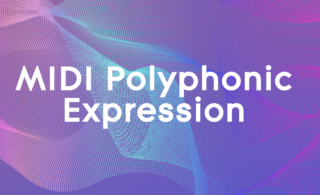 The MIDI Association has released MPE v1.1, an update to the MIDI Polyphonic Expression (MPE) (v1.0, January 2018) specification that’s designed to help accelerate adoption.
The MIDI Association has released MPE v1.1, an update to the MIDI Polyphonic Expression (MPE) (v1.0, January 2018) specification that’s designed to help accelerate adoption.
MPE is a MIDI standard that’s designed to support per-note expressive control, with up to three dimensions of expression.
Without MPE, expressive gestures, like pitch bend and the mod wheel, control all notes similarly. With MPE, every note a musician plays can be articulated individually, for much greater expressiveness.
In March of 2021, the MIDI Association’s MPE Working Group met to evaluate the current MPE specification and create an editorial revision. The Working Group revised the MPE v1.0 specification, with the goal of making it clearer and easier to adopt.
Here’s what they have to say about the update:
“No technical design changes were made while every point of confusion or misinterpretation we’ve encountered over the past few years has been addressed. All the implementation rules are now gathered together into section 2, Detailed Specification.
Further, the best practices and appendices have been elaborated to provide greater detail and examples.”
The next step for the MPE Subcommittee is to create a MIDI 2.0 MIDI-CI Profile for MPE, taking advantage of MIDI-CI to enable auto-configuration between MPE senders and receivers, with a goal to complete this work in 2022.
The members of the MPE Working Group include:
- Gregory Pat Scandalis – moForte Inc
- Athan Billias – MIDI Association-President/ MIDI2Marketing LLC
- Mike Kent – AmeNote Inc
- Geert Bevin – Moog Music Inc
- Eric Bateman – Keith McMillan Instruments
- Andrew Mee – Yamaha Consultant
- Jonathan Keller – Zivix
The working group also consulted with a variety of other hardware manufacturers, plugin developers and DAW vendors to make sure their input was reflected into the updated specification.
The new specification is available for download on the MIDI.org website.
via Geert Bevin

Excited about this! Go MPE!